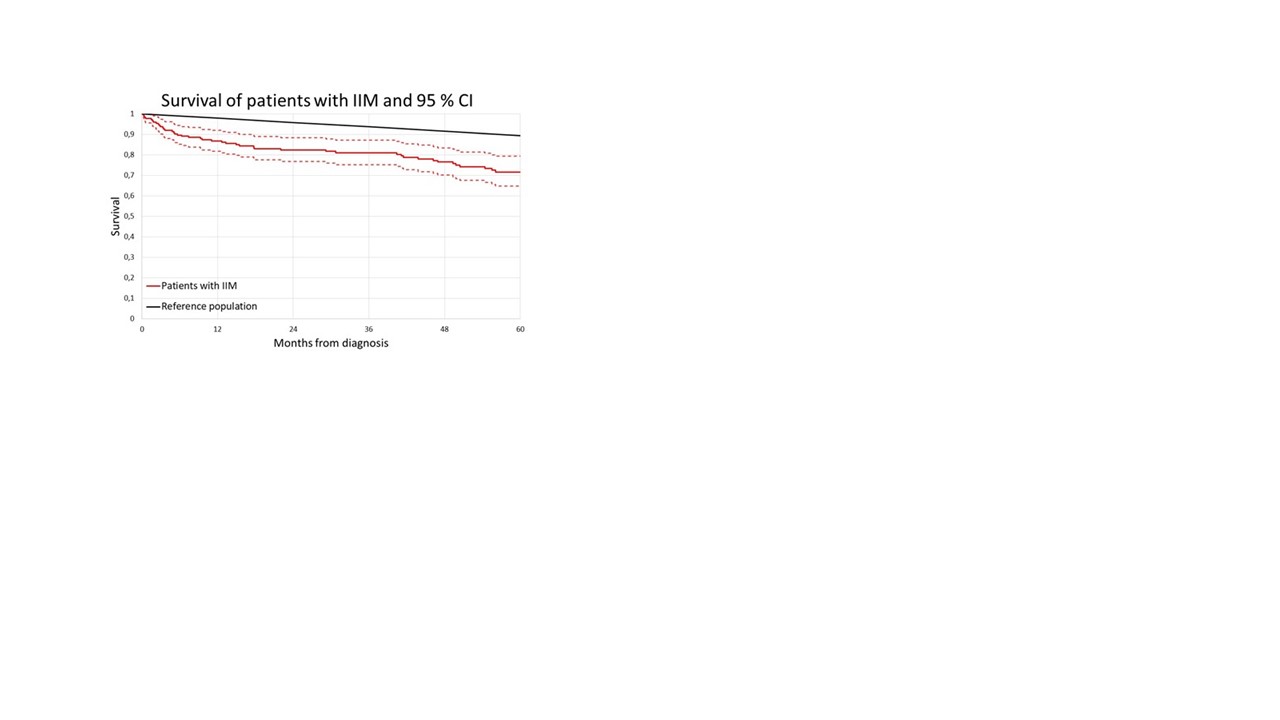Session Information
Date: Monday, November 8, 2021
Title: Epidemiology & Public Health Poster III: Other Rheumatic & Musculoskeletal Diseases (1022–1060)
Session Type: Poster Session C
Session Time: 8:30AM-10:30AM
Background/Purpose: Idiopathic inflammatory myopathies (IIM) are a group of rare systemic diseases associated with significant morbidity and mortality. The aim of our study was to study for the first time the survival of IIM patients in Slovenia.
Methods: We included IIM patients diagnosed between January 2005 and December 2020, and followed at our secondary/tertiary rheumatology center. To evaluate mortality the censor date of April, 14 2021 was set. Kaplan–Meier analysis was used to analyze mortality. A standardized mortality ratio (SMR) was calculated using data of age and sex matched Slovenian population as the reference. Logistic regression was used to study prognostic risk factors in IIM.
Results: During the 16-year observation period, we identified 174 new IIM patients (121 (69.5%) females, median (IQR) age 63.5 (52.1-73.1) years, range 22 to 94 years). We diagnosed polymyositis, dermatomyositis, antisynthetase syndrome, other overlap IIM, necrotizing myopathy and inclusion body myositis in 15 (8.6%), 66 (37.9%), 47 (27.0%), 23 (13.2%), 21 (12.1%), and 2 (1.1%) patients, respectively.
Patients were followed for a median (IQR) 56.6 (20.8 – 107.0) months. During follow up 57/174 (32.8%) IIM patients deceased. The causes of death were cancer (18/57 (31.6%)), infections (13/57 (22.8%)), cardiovascular disease (14/57 (24.6%)), and active IIM (4/57 (5.3%)). In 9 patients the cause of death was unknown. One- and five-year survival rate was 86.7% and 71.6%, respectively. We found no significant sex related differences in the net survival estimates during the first five years of follow up (p=0.13). Figure 1 shows the survival curve of IIM patients and general population as a comparator according to Kaplan–Meier analysis. The mortality of patients with IIM patients was significantly higher compared to matched general population. In the table 1 the standardized mortality ratios in IIM patients are presented. In the first year following IIM diagnosis the SMT was almost 8-times higher compared to the general population (SMR 7.95 (95%CI 5.04-11.93). The risk remained higher also during the following four years. As prognostic risk factors emerged increasing age (OR 1.08 (95%CI 1.05-1.12); p< 0.001), antisynthetase syndrome (OR 2.61 (95%CI 1.09-6.28); p< 0.032), Raynaud phenomenon (OR 0.21 (95%CI 0.07-0.66); p< 0.007), and cancer (OR 6.21 (95%CI 2.29-16.85); p< 0.001).
Conclusion: The survival of patients with IIM patients was substantially worse compared to matched general population. Cancer was the leading cause of death in our IIM cohort.
 Table 1. The standardized mortality ratio of IIM patients
Table 1. The standardized mortality ratio of IIM patients
 Figure 1. Survival curve according to Kaplan–Meier analysis in IIM
Figure 1. Survival curve according to Kaplan–Meier analysis in IIM
To cite this abstract in AMA style:
Hocevar A, Virscek A, Krosel M, Tomšič M, Rotar Z. Survival of Patients with Idiopathic Inflammatory Myopathy in Slovenia [abstract]. Arthritis Rheumatol. 2021; 73 (suppl 9). https://acrabstracts.org/abstract/survival-of-patients-with-idiopathic-inflammatory-myopathy-in-slovenia/. Accessed .« Back to ACR Convergence 2021
ACR Meeting Abstracts - https://acrabstracts.org/abstract/survival-of-patients-with-idiopathic-inflammatory-myopathy-in-slovenia/
